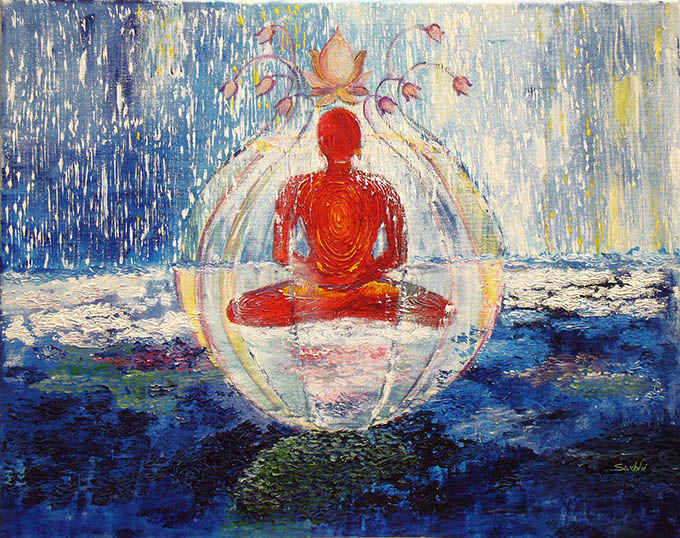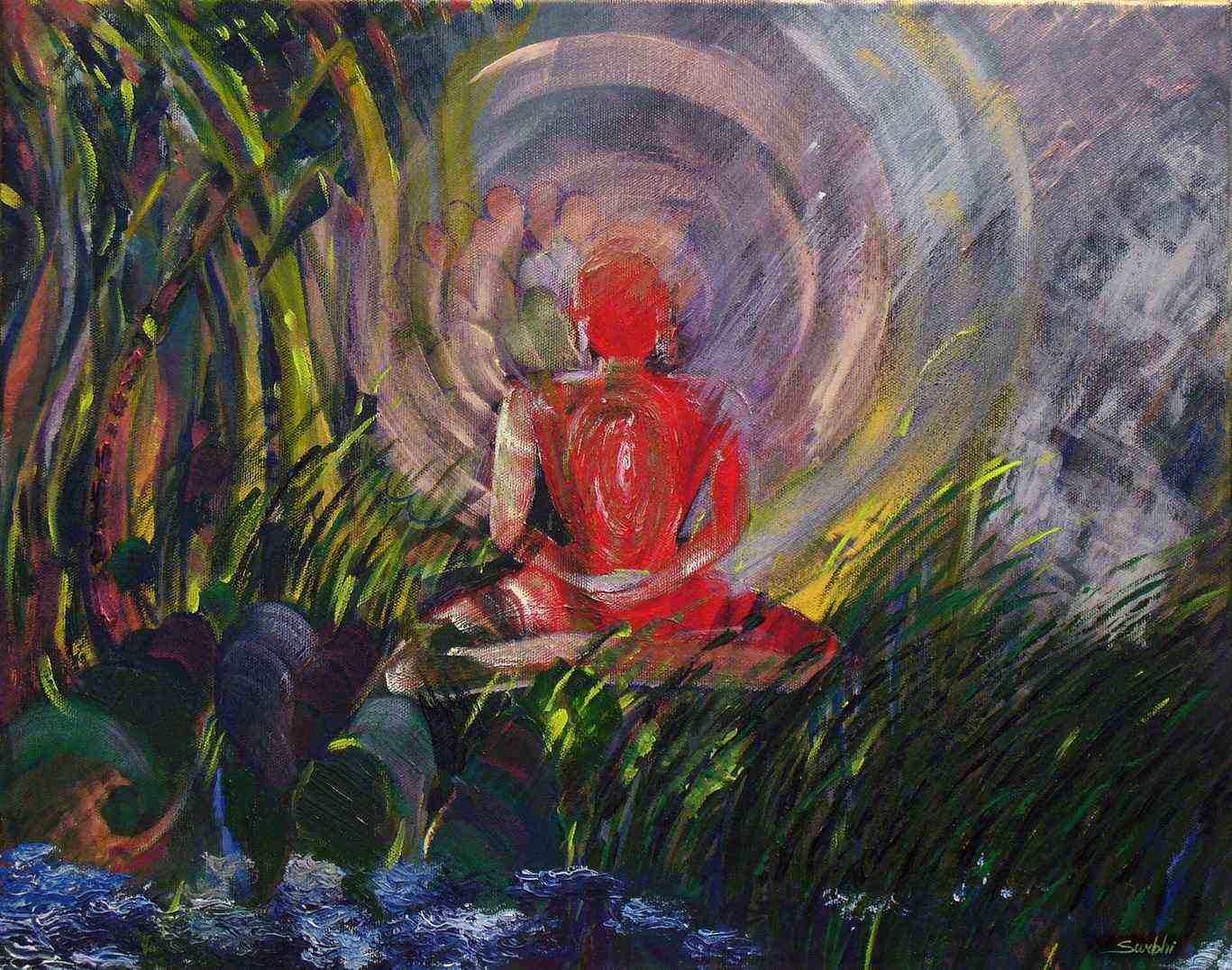Art by Surbhi Pandya

Five Elements (The Human potential)
View Artwork
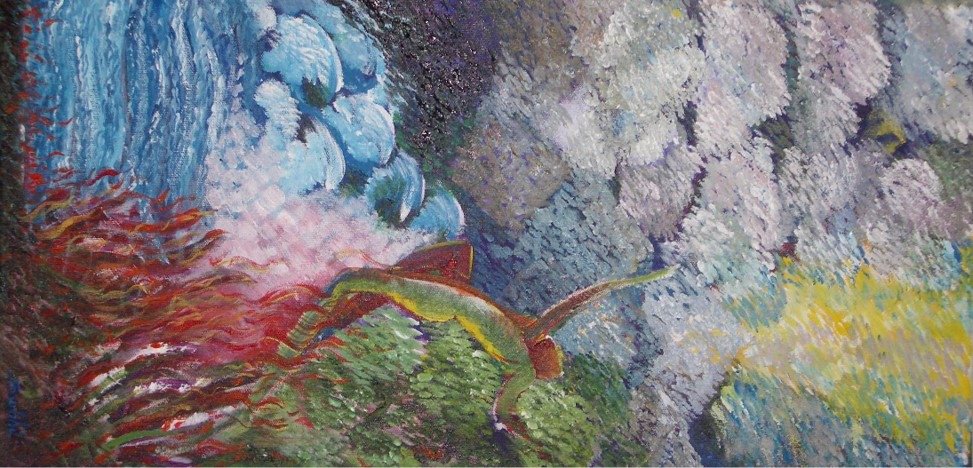
Five Elements (The Human potential)
“Who fears to follow where airy voices lead” by Surbhi Pandya
A man amidst the elements of nature – air, water, fire, earth and plants is the only living being that has the daringness to follow the soul’s true path to Moksha. Other forms of life are ignorant about it.

Four Kashaaye
View Artwork

Four Kashaaye
“Four Emotions: Follow your bliss and the universe will open doors for you where there were only wall” by Surbhi Pandya
The four Kashayes ( Anger, Pride, Deceit, Greed) are the types of passion that inhibit the true expression of one’s soul. However as we attain True Perception, these walls that symbolize passion melt down and open doors to Spiritual bliss.

Karmas
View Artwork
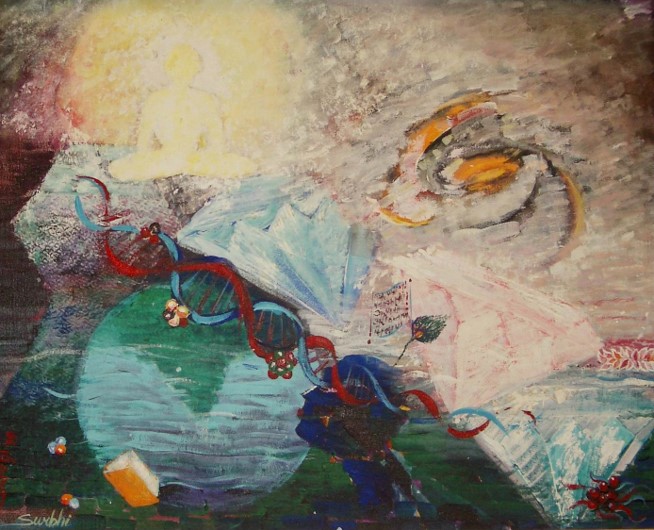
Karmas
“Transmigration Of Genes” by Surbhi Pandya
This painting denotes the transmigration of genes through the concept of karmas, which continue to remain attached with the souls throughout the life as well as in migration of soul from one body to another.
The three brilliant diamonds in the painting represent that through the combination of the three jewels, Right Faith (Samyak Darshan), Right Knowledge (Samyak Gyan) and Right Conduct (Samyak Charitra), humans can eradicate all karmas which cause sufferings and attain “Moksha”. Moksha is the purest state of a soul without delusion and devoid of karmic particles.
The three brilliant diamonds in the painting represent that through the combination of the three jewels, Right Faith (Samyak Darshan), Right Knowledge (Samyak Gyan) and Right Conduct (Samyak Charitra), humans can eradicate all karmas which cause sufferings and attain “Moksha”. Moksha is the purest state of a soul without delusion and devoid of karmic particles.

Panch-parmeshthi
View Artwork
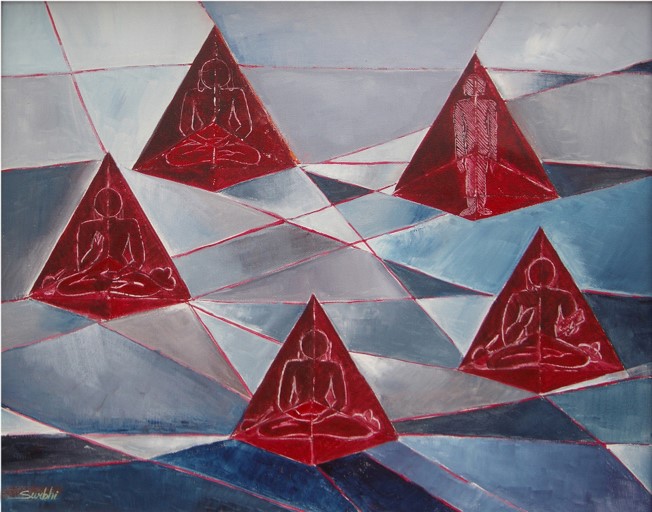
Panch-parmeshthi
“Serenity isn’t freedom from the storm, but peace within the storm” by Surbhi Pandya
The spiritual Gurus: Arihant, Siddha, Achaarya, Upaadhayay, Saadhu, are the five venerable personalities.
Arihant – They have destroyed their internal enemies (kashaaye) completely and are free from the Karma bondage of the major types.
Siddha – These have attained Moksha, having completely destroyed all the Karmas.
Acharya – They are the head monks who administer their Sangha.
Upadhyay – They are the teacher monks who look after the teaching of the scriptures.
Sadhu – They have given away all wordly possessions and pursue self enlightenment.
Arihant – They have destroyed their internal enemies (kashaaye) completely and are free from the Karma bondage of the major types.
Siddha – These have attained Moksha, having completely destroyed all the Karmas.
Acharya – They are the head monks who administer their Sangha.
Upadhyay – They are the teacher monks who look after the teaching of the scriptures.
Sadhu – They have given away all wordly possessions and pursue self enlightenment.

Presence (Mystery Within)
View Artwork

Revolution
View Artwork
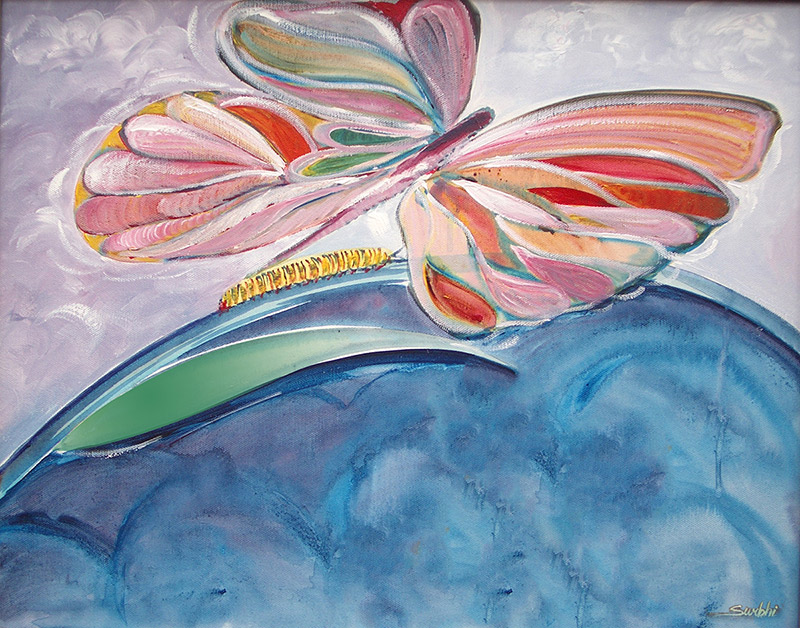
Revolution
“Any revolution has to start with the transformation Paryaay Parivarta” by Surbhi Pandya
The mark of your Ignorance is the depth of your belief in Injustice and Tragedy. What the caterpillar calls the end of the world; The master calls a butterfly.” – ILUSIONS ” The call of death is a call of love. Death can be sweet if we answer it in the affirmative, if we accept it as one of the great eternal forms of life and transformation.” Swastik in the painting denotes the four realms of existence namely heaven, humankind, animal world and hell, in which the soul wanders on account of Ignorance.

Six Leshyas
View Artwork

Six Leshyas
“Colors of our Thoughts” by Surbhi Pandya by Surbhi Pandya
In this painting the soul is immersed in a valley of six colored mountains symbolizing the six Leshyas. The mountains are formed by the activities of the chakras (centers of energy) in the human body. The three lower chakras are responsible for lower emotions thus generating the three inauspicious leshyas: Krishna (Black) Leshya, Neel (Blue) Leshya and Kapot (Brown) Leshya. When we dwell in auspicious activities or thoughts, our higher chakras get activated, thus generating the remaining three auspicious Leshyas: Peet (Yellow) Leshya, Padma (Pinkish) Leshya, Shukla (White) Leshya.

Sukh
View Artwork
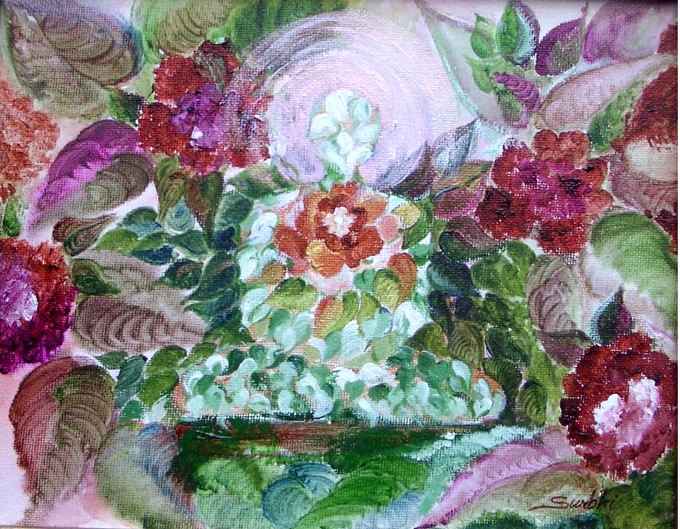
Sukh
“Non-being – the glorious state of absoluteness” by Surbhi Pandya by Surbhi Pandya
Flowers have many attractive qualities. Vivid colors, soothing aromas, pretty formations to name a few. Like flower, our soul has many qualities to be realized only through self-exploration. All attractive things are desired by us humans and we work hard to possess them. But soul, the most beautiful thing in this world, needs no possession. It blossoms within us.

Sun Salutation
View Artwork

Sun Salutation
“Akrutrim Chaityaalay in Sun” by Surbhi Pandya
Sun Salutation is widely performed today. In some religions Sun is worshipped as a God. However, Jain cosmology doesn’t consider Sun as supernatural being but regards it as an independent matter body consisting of Akrutrim (self existing) Jinaalaye. Bharat Chakravarti with his exceptional eyesight was able to see these Jinaalaye and saluted the Sun . Science believes that Sunbathing heals skin cancer, strengthens muscles and alleviate depression.

Wisdom
View Artwork

Wisdom
“Only if a Man knew what is worth achieving” by Surbhi Pandya
Life goes on. The disease of the mind is more dangerous than the disease of the body. The body will die one day but the ignorance stays with the soul. We need to make proper use of our thinking faculty and learn to surrender our ego. Choose wisdom.

Wonder
View Artwork
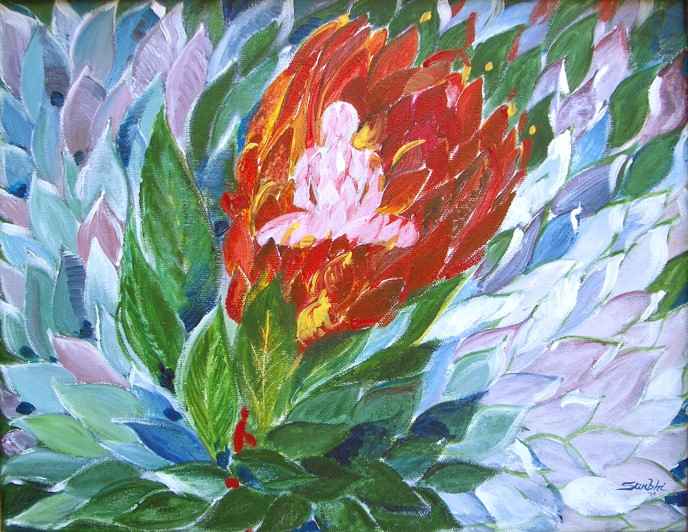
Wonder
“Each flower is a soul blossoming out to nature” by Surbhi Pandya
If we could see the miracle of a single flower clearly our whole life would change. It’s blossoming stirs enduring affirmations and discoveries, and can surely help the spectator in his search for identification with the vast world of natural beauty and the wonder surrounding him.

Atma Vaibhav
View Artwork

Antar-Atma
View Artwork
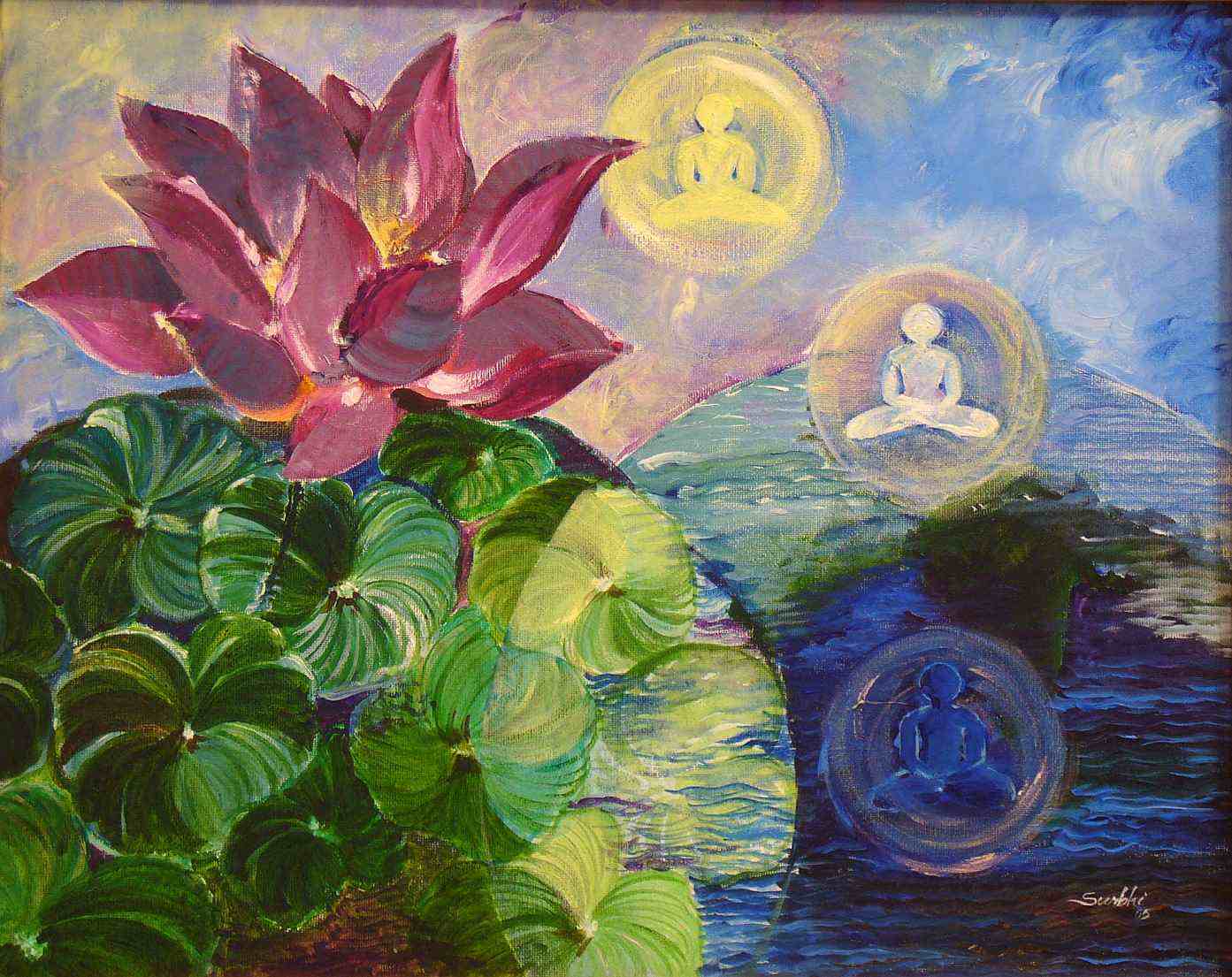
Antar-Atma
“The Intelligence: Enlightenment is the quiet acceptance of What Is ” by Surbhi Pandya
Lotus blooms magnificently in a muddy pond, remaining untouched by its dirt. Similar is the endeavor of an enlightened soul. It lives in the world untouched by the affairs of the world.
In the painting is shown three states of soul. Bahir-atma is the soul lost in worldly affairs. Antar-atma is the soul like a lotus flower who rides safely through ups and downs of life. Most commonly known, Param-atma is the soul who has achieved the ultimate happiness by attaining Moksha.
In the painting is shown three states of soul. Bahir-atma is the soul lost in worldly affairs. Antar-atma is the soul like a lotus flower who rides safely through ups and downs of life. Most commonly known, Param-atma is the soul who has achieved the ultimate happiness by attaining Moksha.

Anekant-vaad
View Artwork
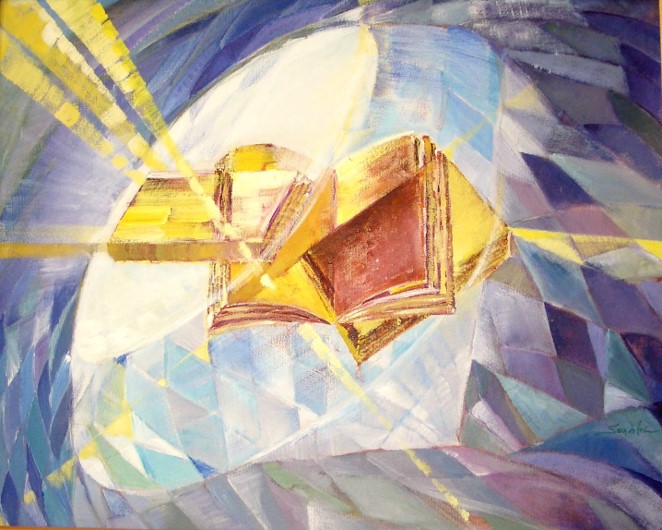
Anekant-vaad
“The Multifaceted Reality” by Surbhi Pandya
Anekanta is the appreciation of the manifold attributes of a substance. Recognizing the incredibly rich and complex nature of reality, Jainism recognized the concept of “Many sidedness”. The Diamond with multiple facets denotes Anekanta. Truth is relative to the perspective from which it is known. Thus, the concept of Absolute truth (the nature of substance that comprises of different but opposite attributes) and Relative truth (description of the substance from a particular viewpoint) were formed. In the painting, brilliancy of the Diamond represents Absolute truth. Reflection of light through a particular facet signifies Relative truth.

